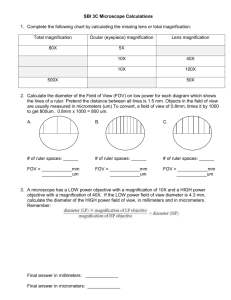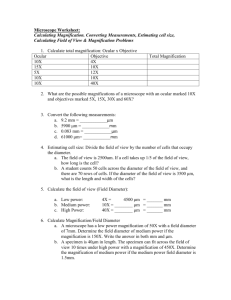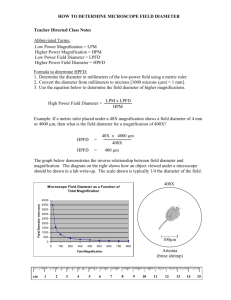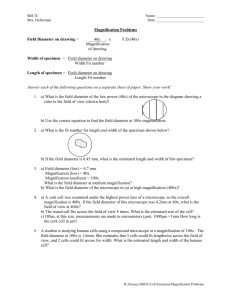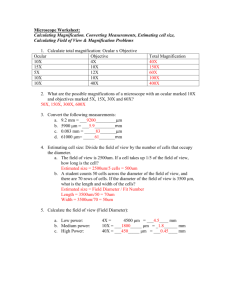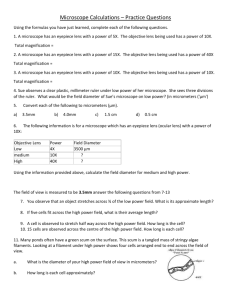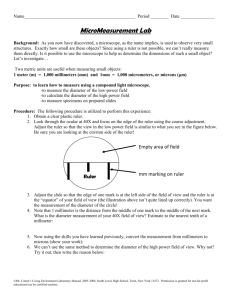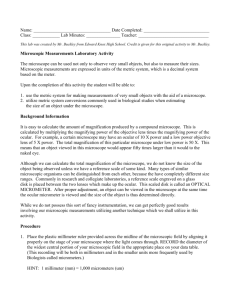Measuring With The Microscope
advertisement
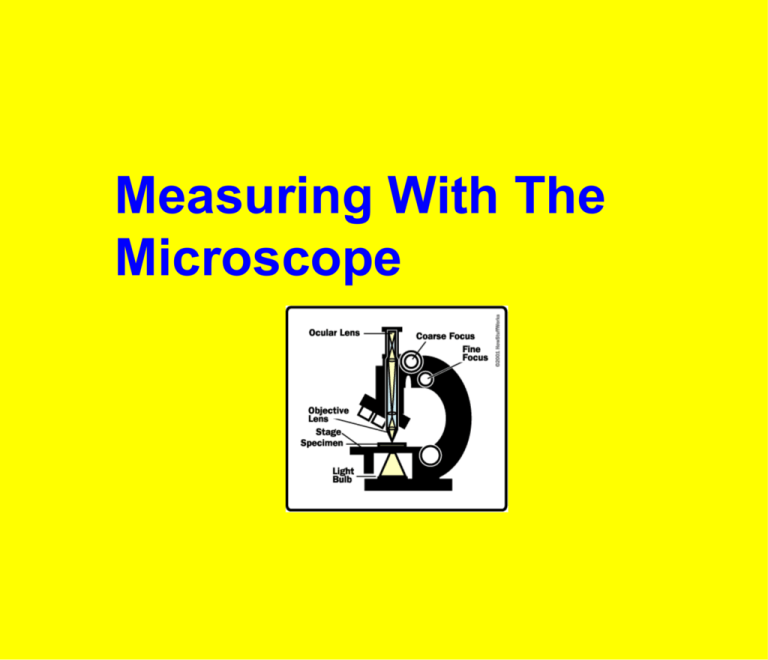
Measuring With The Microscope Image : What we see when we use a microscope to examine a specimen. Magnification the ratio of image size to object size (the amount of times the image is enlarged when compared to the real size of the object) Example - 50X : the capacity (ability) of a microscope to show two points that are very close together as being separate from each other. How can we measure the size of objects under the microscope? "Field of view" or "Field of Vision" FOV The area of the slide that you see when you look through a microscope's eyepiece. The diameter of the low power field of view is determined by using a clear metric ruler. How wide is the field of view in millimeters? micro When we use a MICROscope we use MICROmeters. 1000 micrometer (um) = 1 millimeter (mm) .. One strand of hair = 100 um wide To convert from millimeters to micrometers, move the decimal 3 places to the right. EX: "Field of view"= 1.3mm How wide is the field in um? 1.3mm How can we measure the size of objects under the microscope? How big is the cell Field of view in LP= 1000 micro meters How many "objects" fit in the field of view? What is the size of ONE of the "objects?" 3 cells = 1000 microns 1 cell = ___________ microns diameter of the field of view number of cells that fit Lets try some conversions: 1) 5.0mm= um 2) 1.8mm= um 3) 1.65mm= um 4)1300um= mm 5)1500um= mm 6) How big is each object in um if the field of view = 1500um? 1500um When we switch from low power to high power you see a smaller area of the slide under High power. This is why centering what you want to see, prior to switching to high power is so important. h h High Power Low Power How do we find the diameter of a high power field of view? We use the formula below Low power magnification = High power magnification High Power field diameter Low power field diameter What is the high power field diameter? 2.0mm Low Power 10X ??? High Power 40X = Low power magnification High Power field diameter Low power field diameter High power magnification ??? 2 mm Low Power 10X High Power 40X What is the high power field diameter? 40 X = 20 mm X = 20 40 .5 mm = 500 microns 1) Which is bigger a mm or a um? are larger. 2)HowThe many mm um are there in 1mm? 3)Which objective , low or high power would give you the largest field of view? There are 1000 um in 1 mm. 4) Which objective provides the most detail ? High or low? 5) If the field diameter is 5000um The andlow 5 cells fit across, what is the length of one power objective. cell? in um? in mm? 1 cell = 1 cell = 5000 um 5 cells 1 cell = 1000 um = 1 mm diameter______ total number of cells Example #1: ocular power = 10x low power objective = 10x high power objective = 50x a) What is the highest magnification you could get using this microscope ? b) If the diameter of the low power field is 2 mm, what is the diameter ofthe high power field of view in mm? in micrometers ? IOx X 50 x =5OOx c) If 10 cells can fit end to end in the low power field of view, how big is each cell in mm ? um? b) Low power magnification High power magnification = High Power field diameter Low power field diameter 10 = X 50 2.0 mm 50 X = 20 mm X = 20 = .4 mm 50 .4 mm X 1000 = 400 um c) diameter 2mm 1 cell = .2 mm =200um # of cells 10 cells Example #2: ocular power = 10x 1m 1m 1m 1m low power objective = 10x m m m m high power objective = 40x The diagram shows the edge of a millimeter ruler viewed under the microscope with the lenses listed above. The field shown is the low power field of view. a) What is the approximate width of the field of view in micrometers ? b) What would be the width of the field of view under high power ? c) If 5 cells fit across the high power field of view, what is the approximate size of each cell ? b) 10 x = X 40 4.0mm 40 X = 40 mm X = 1 mm = 1000 um c) 5 cells = 1000 um 1 cell = 1000um 5 1 cell = 200 um =.2 mm
